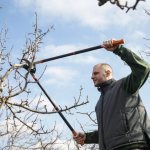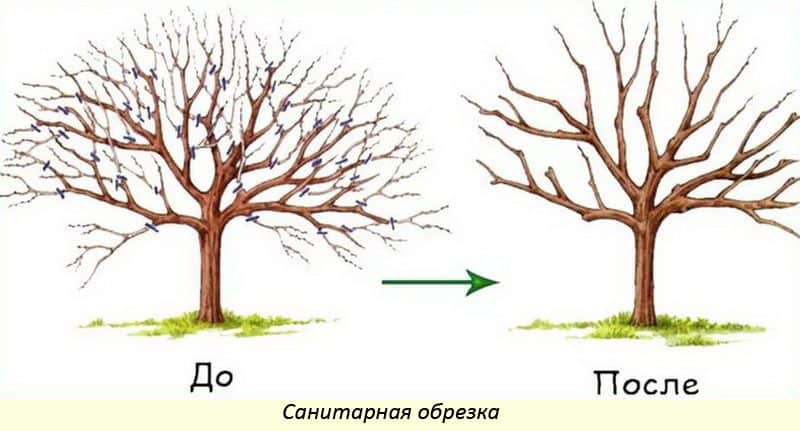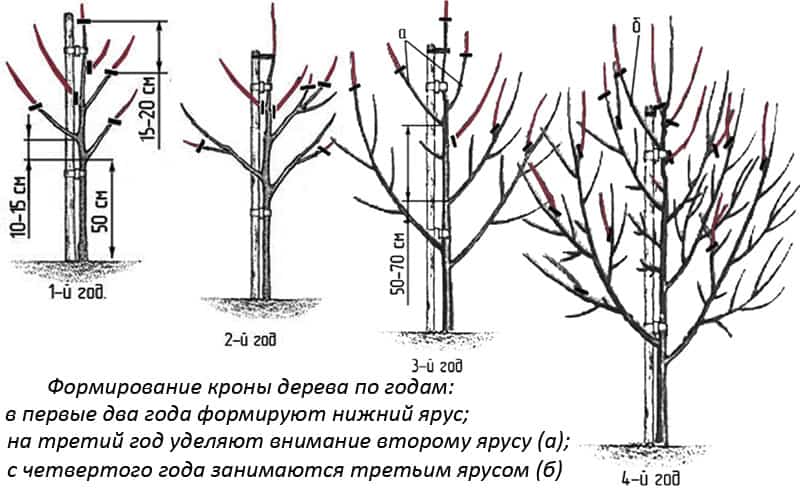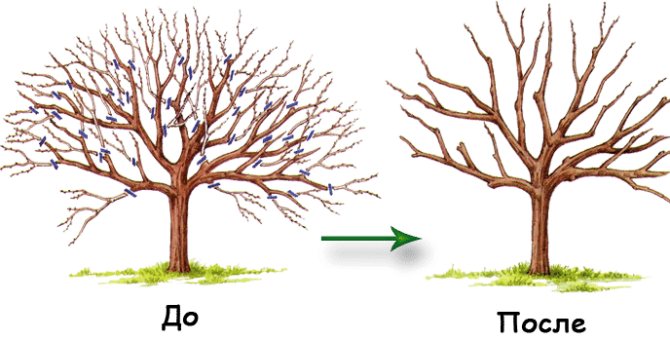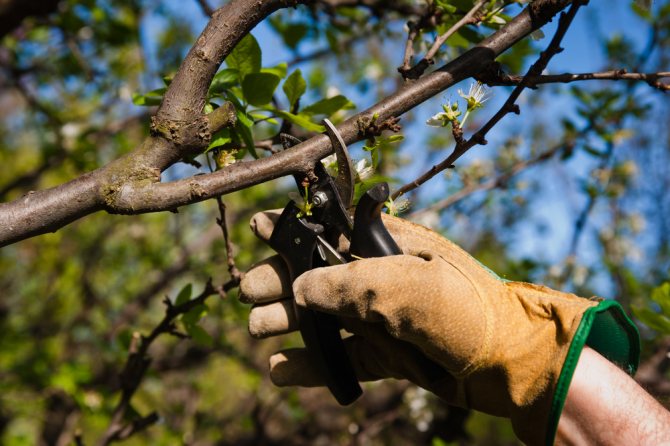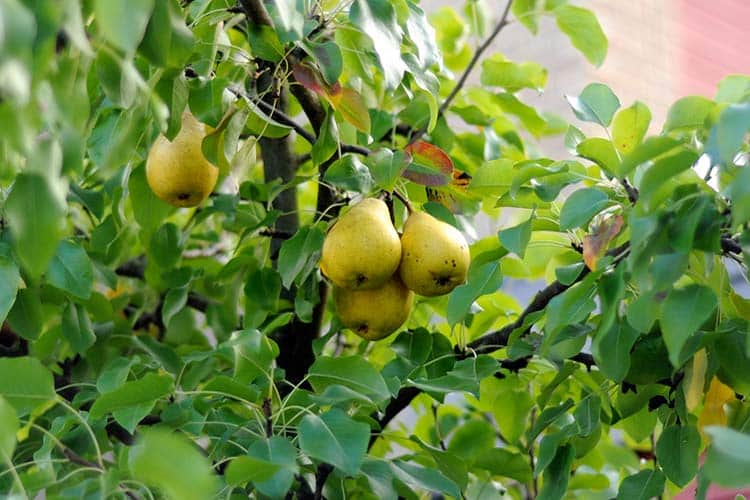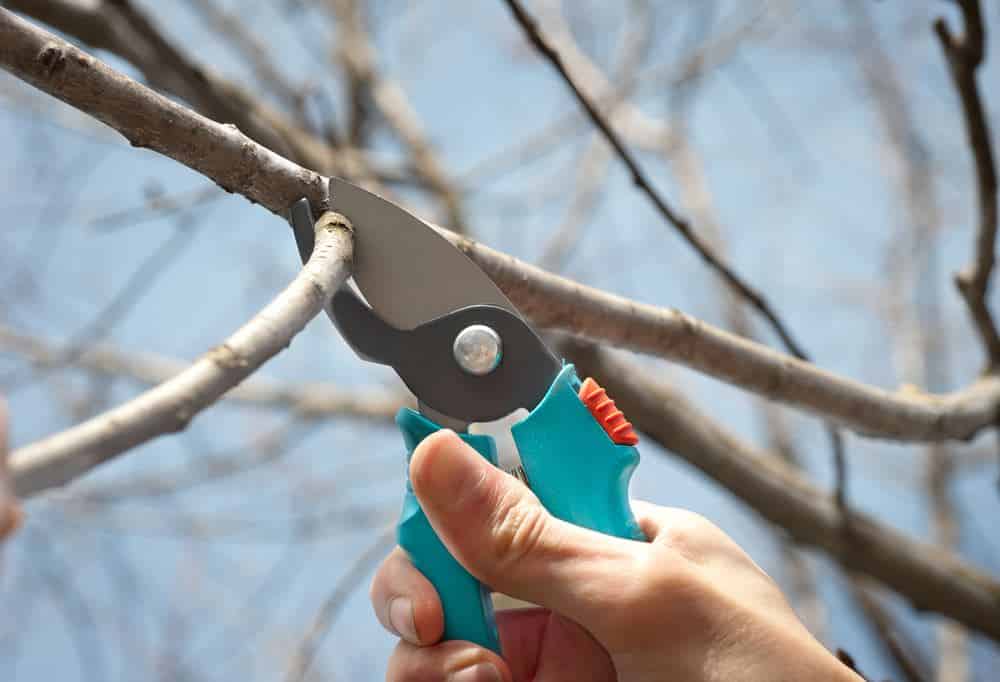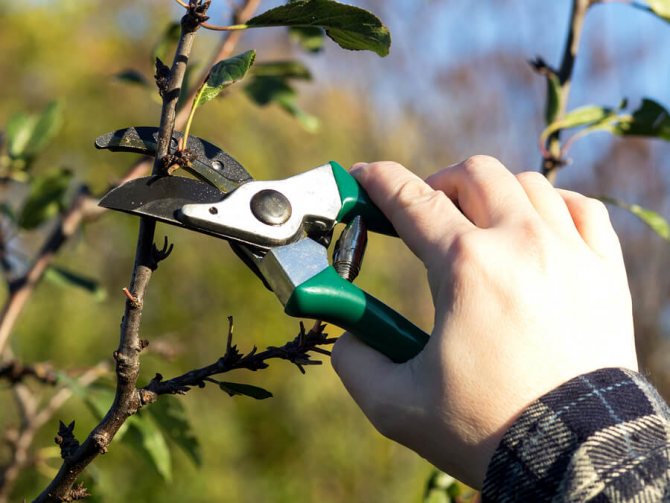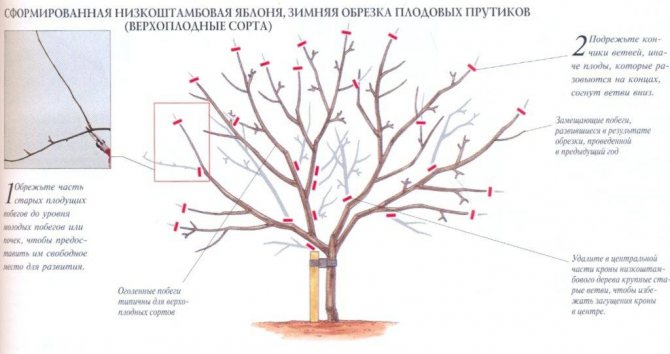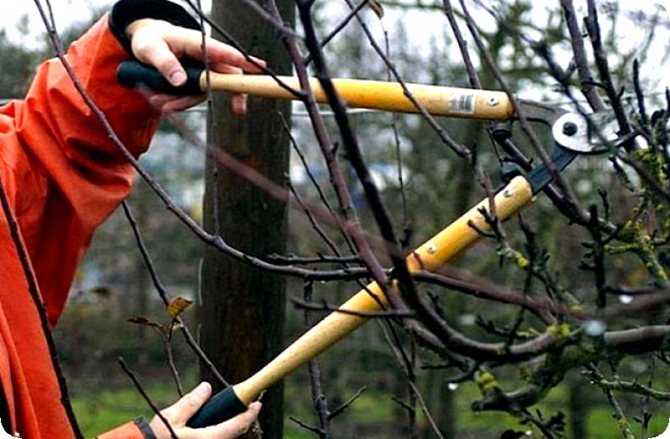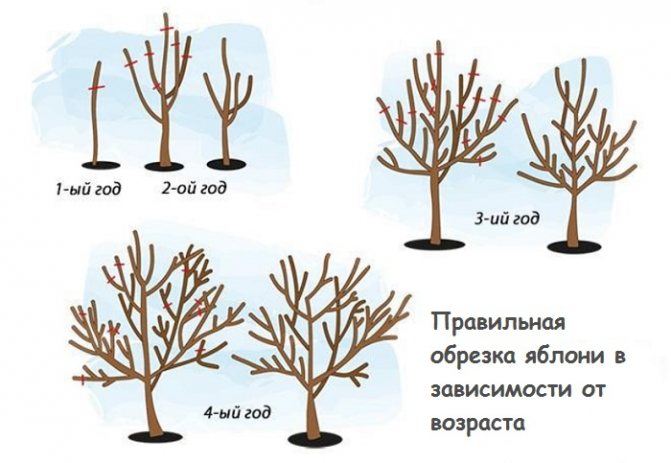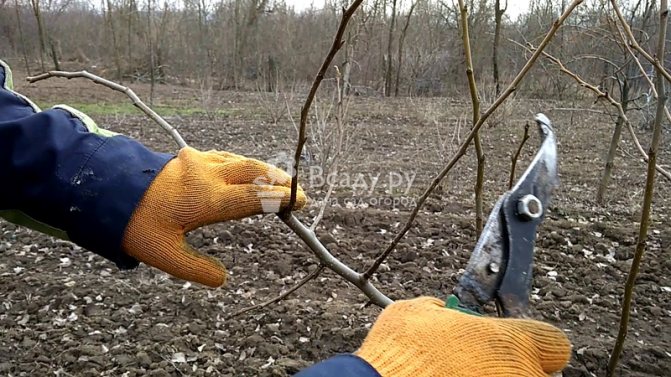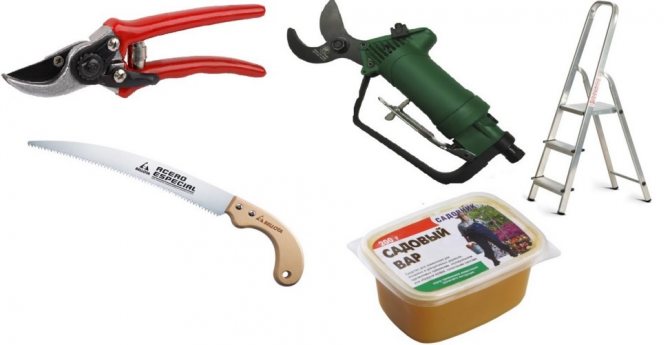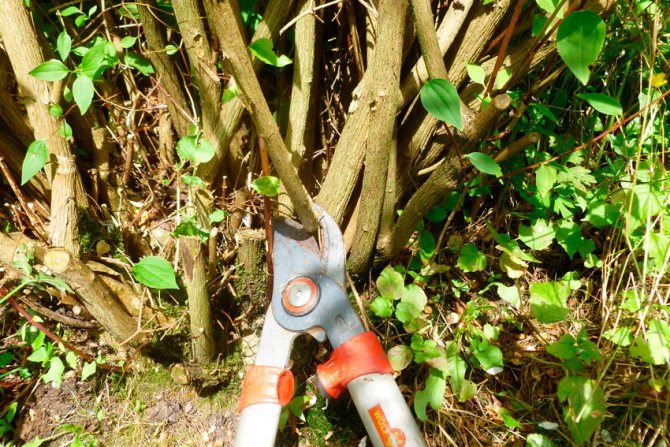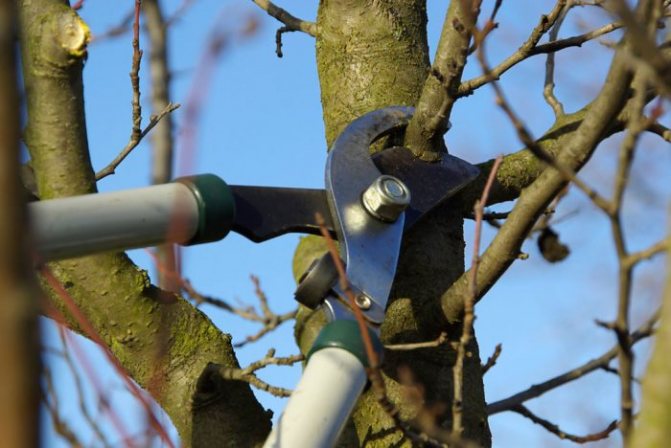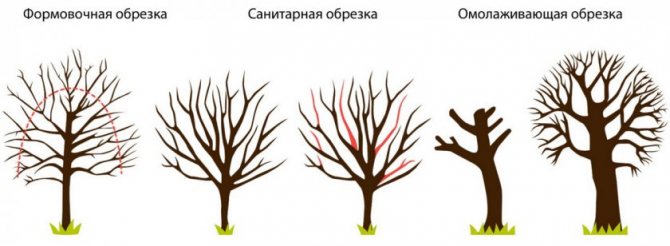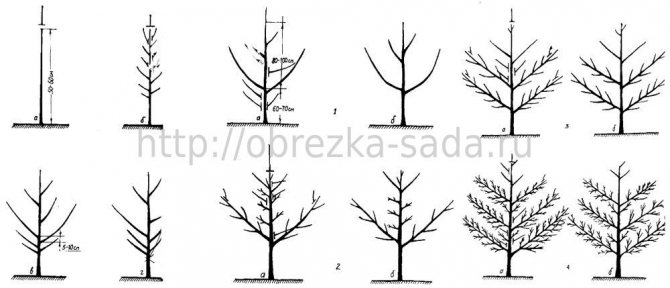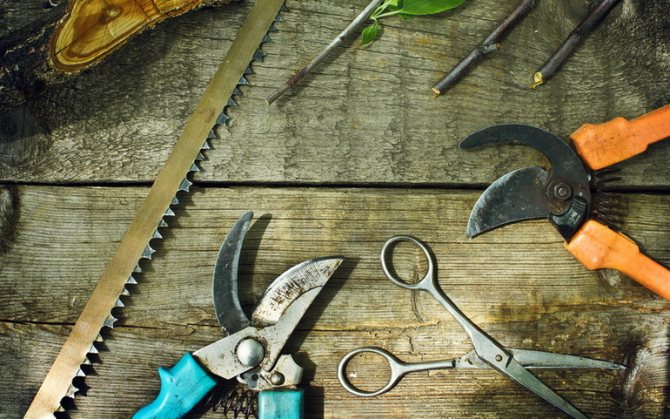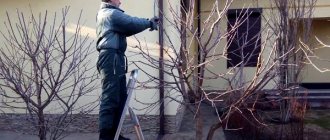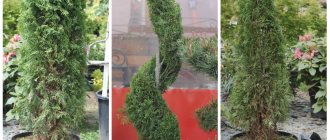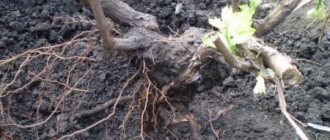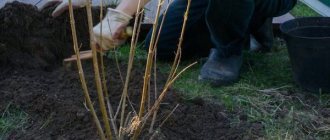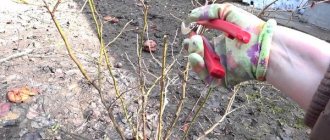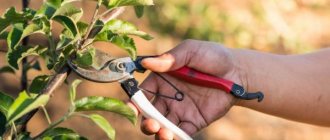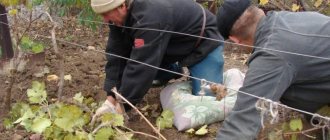Gardening »Pear
0
1844
Article rating
In order for a planted seedling to give good yields in the future, it must be properly formed. Let's consider how to properly form a pear. We will also talk about how often you need to prune the branches of the tree so as not to harm the plant.
Correct pear formation
The optimal timing for pruning pears in spring
Spring pruning of pears must be done before the juice begins to move in the shoots (i.e. before bud break).
Controversial! At the same time, some gardeners advise to carry out the procedure when subzero temperatures are still confidently holding (but not lower than -10 degrees), while others recommend that the air temperature, on the contrary, be positive (about +5). In any case, the duration of the pruning period is before bud break.
We advise you to read these articles:
Treating trees in spring during bud break
Shrub treatment in spring during bud break
Treatment of shrubs in the spring from pests and diseases with a Bordeaux mixture
Of course, it is quite difficult to indicate the exact dates: spring in different regions, depending on the climate, starts at different times. The main thing is to be in time before the start of sap flow.
However, you can name the approximate dates. So, pruning of pears in the spring in the Middle Lane (Moscow region), as a rule, is carried out already at the end of March - early April, in the South of Russia - at the end of February-March. And in the more northern (in the North-West - in the Leningrad region) and cold regions (in the Urals and Siberia), spring pruning of pears is carried out in the second half of April.
Common mistakes
Among the most common mistakes when pruning a tree for beginners is incorrect pruning "to the kidney." They do this below it, which leads to its freezing, or they leave a large stump. In the second case, the plant can get sick, because it does not heal and pathogens can easily penetrate through it.
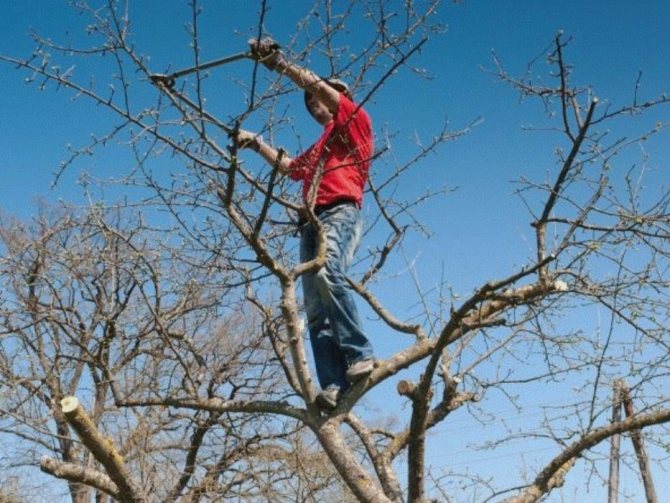
For the cut to be correct, it must be slightly higher than the kidney, and it must be at the level of the lower cut. When trimming "on a ring", the rules are the same. If a large stump remains, then extra shoots grow on it, taking away the strength from the pear. It is also impossible to cut the branches low.
Other common mistakes include:
- failure to meet deadlines. Some gardeners start forming a culture in July - the worst time you can imagine. During this period, the procedure will weaken the plant and delay its growth. It is better to postpone the circumcision in the fall, when the foliage falls. But the ideal option is early spring;
- not removing dry, diseased and broken branches;
- not thinning the crown.
To avoid these mistakes when pruning pears in spring, you should familiarize yourself with the rules of procedure and its types in advance.
Inexperienced gardeners often make unforgivable mistakes that lead to the death of trees. To avoid such consequences, you should familiarize yourself with the video for beginners before the procedure. It shows you a step-by-step process of trimming, so there will be no difficulties.
Pruning young pears in spring


Pear pruning starts from the first year and continues throughout the life of the tree.
- The first time a pear seedling is pruned when planting in spring or autumn.This is necessary in order to maintain a delicate balance between the aboveground part of the plant and its root system, which will not be able to fully supply the growing crown with nutrients.
- Young trees should undergo formative pruning at least 2 times a year (in spring and autumn). Its intensity depends on the tendency of a particular cultivar to branch.
- Along with pruning, in young fruit trees, in order to form a larger number of fruit buds, such an agrotechnical technique as bending of branches is used. The branches are tied with a twine loop to the supports driven into the ground so that they take a horizontal position. The procedure is carried out in the spring and summer. Bending the pear branches closer to a horizontal position promotes the formation of fruit buds.
- So that the twine, wire or rope, with the help of which the bending is carried out, does not cut into the branch, disrupting the circulation of nutrients, a lining is made under them.
- The second tier of branches on a young pear is formed not earlier than the 4th year of development. By the age of five, the intensive growth of the branches slows down and the pruning of the tree becomes more moderate.
Pruning methods and types
In order to always have a good harvest, it is recommended to carry out sanitary and formative pruning of the pear. Sanitary is done to remove damaged or dried out branches. These parts of the plant are useless and even dangerous for him: pests parasitize them and fungi grow on them. This operation can be performed at any time of the year.
But the pear needs the formation of the crown. The tree has a high vigor of growth. And the gardener should make life easier for himself: limit the size of the tree, thin out its crown for ease of care and collection of fruits. Summer residents are interested in: is it always necessary to cut the lower branches of a tree? This operation is carried out to remove old branches or to facilitate maintenance: it should be convenient to move under the tree while weeding or feeding.
Pruning scheme for a five-year-old pear:
- First of all, I cut off the side branches to limit their growth,
- I cut off all the branches that grow inside the crown,
- I cut off the branches that lie down and hang on other shoots. This is dangerous, since in this case both branches die out due to the fact that the bark rubs against each other, is damaged and dies off. And the branches eventually dry up
- Pruning broken, dry branches
- I shorten the branches to get a good growth of shoots,
- Be sure to cut the conductor near the pear to leave the tree growing. Then it is fashionable to get a not high pear.


Pruning must be done with a clean and sharp pruning shears. I cut the shoots into a ring so that the places of the cuts grow faster. The tree stump should not be left as it is mainly occupied by pests and infections.
Leaving after spring pruning
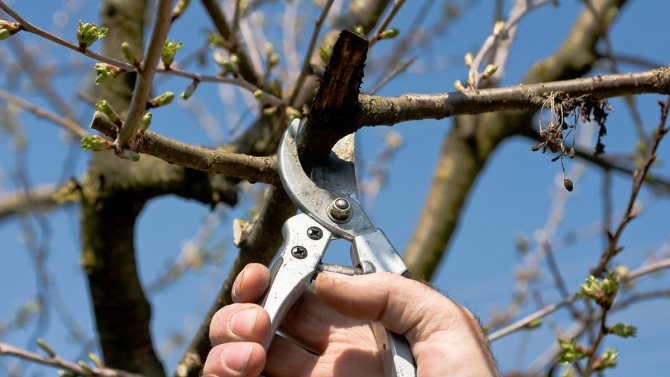

After the completion of the crown, the trimmed shoots must be removed from the garden, and those affected by diseases can be burned. Treat the places of cuts on the tree with garden varnish. But if the air temperature is less than 8 ℃ above zero, then paint over with oil-based paint. This applies to slices with a diameter of 1 cm. Thanks to this approach, infections will not penetrate deep into the culture, like insect pests, and nutrients will not be lost.
Attention!
Do not feed the pear immediately after pruning.
Basically, pears do not experience stress if the formation of the crown was carried out on time and in compliance with the rules.
Formative pear pruning
Crown formation of this type of pear is applied to seedlings or young plants. If you hold it on time and correctly, then the tree will grow and develop as expected. If the skeletal branches are distributed, it is true, then fruiting will be early, and the formation of fruits will be full.
Attention!
Formative pruning on an adult pear concerns the removal of tops on the main shoots.
The rapid growth of branches can be stopped by shortening them. A similar manipulation is carried out over young plantings.The crown becomes compact as a result.
But before pruning, you need to choose a crown for the pear. To do this, you should pay attention to the conditions for growing the crop. Sparse-tiered and cup-shaped plants are more common.
Why do you need spring pruning of trees
If you do not cut the plant, then vertical branches will form on it, and it itself will stretch out. As a result, the number of fruits decreases, and the resistance to disease and frost decreases. Gardeners are constantly removing damaged and excess shoots in order to increase the fruiting period of the pear and improve the conditions in which the fruit is grown.
It may be interesting How and when to plant a pear correctly in the spring: step-by-step instructions for beginners with photos
Objectives of the procedure:
- form a strong skeleton;
- getting rid of damaged, improperly growing and dried out branches;
- distribute branches evenly throughout the tree;
- leave the required sizes of shoots from which it will be convenient to harvest;
- ensuring air circulation and access to the required amount of light. If these conditions are not provided, then the kidneys may not only stop their growth, but may not appear at all;
- minimizing the risk of disease and parasites;
- tree rejuvenation.
In the case of timely cropping of the crop, beautiful plants will appear on the site that will bear fruit well for more than one year.
Sparse-tiered pear crown
This type of green mass is the most common and resembles natural forms. On the trunk, shoots are arranged in tiers of 2-3 pieces or singly.
They begin to form the crown of an annual seedling in early spring. For this purpose, a trunk zone is allocated on the main conductor. It is located at a distance of 0.5 m from the surface of the earth. If it is less, then caring for an adult culture will be problematic. In the case of an enlarged stem, the pear will lose its resistance to subzero temperatures and sunburn.
Above the stem, another 30-40 cm must be measured, on which the skeletal shoots of the first tier will be located, and the conductor must be removed at the same time. The cut must be made over a healthy and developed kidney - an extension of the trunk will appear from it. During crowning, the main branch should remain 15-20 cm higher than the shoots growing on the sides.
A year later, in the spring, gardeners clear the bole from the overgrowth. In the first tier, 3 branches should remain, the distance between which along the trunk will be 10-15 cm. Their length is almost the same along one horizontal line. Their growth in circumference will ideally be 100-120 ° among themselves. The rest of the side shoots must be cut off or bent for a while so that they are parallel to the ground. This approach will slow down their growth, and, on the contrary, increase the yield.
Attention!
Branches, the length of which does not exceed 30 cm, can not be removed - fruits will be tied on them. They are almost not inclined to growth.
On a three-year-old tree, 0.5-0.7 m from the lower tier, a new one is laid. It is formed by 2-3 future skeletal shoots. The algorithm is the same as for the formation of the first tier. If the conductor has gone excessively in height, then it must be shortened. Branches that have been folded back do not need to be touched. But if they make the crown very dense, then they will have to be shortened or completely removed.
On a four-year-old pear, after 40 cm from the second tier, you can leave 2-3 branches of the third level. After 1-2 years, the guide on the trunk should be shortened to the upper skeletal shoot growing on the side. The height of the crown should ideally be at least 4-4.5 m.
A set of tools and materials


Correct pruning of pears involves not only strict adherence to the procedure algorithm or weather conditions. It is about the tools used.The final result of the procedure also depends on their choice.
To get rid of unnecessary branches well and efficiently, you will need:
- pruning shears (lopper) - the main tool of the gardener. It can be with a short handle to remove small growths not exceeding 2 cm. Equipment with a long handle will help to trim thick branches up to 4 cm in diameter;
- garden hacksaw with a special sharpening and comfortable handles. It guarantees a smooth cut. Needed to get rid of large branches;
- garden knife. It will be needed for cleaning shoots and trunks, processing cuts, etc.;
- ladder - allows you to reach the highest processes.
The instruments with which the circumcision will be carried out should be prepared in advance. Clean and sharpen cutting parts, ideally disinfect. For this, ordinary alcohol or a solution of potassium permanganate is suitable.
Sanitary pruning of pears in spring
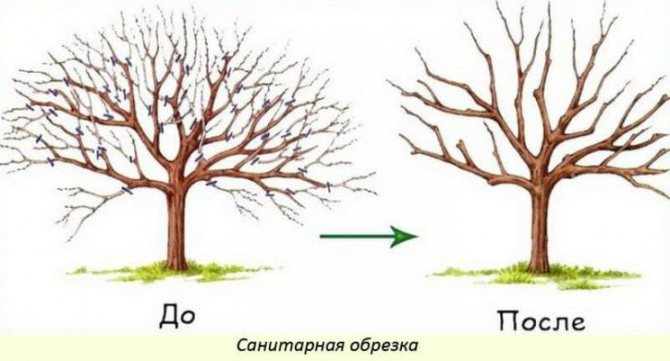

The main purpose of this type of pruning is to maintain the health of the fruit tree. The branches are shortened as needed at any time of the year, provided that the air temperature is favorable. In this case, the following are subject to removal:
- broken or cracked tree shoots;
- adipose, growth processes;
- dry branches affected by pests or disease;
- intertwined shoots.
Sanitary pruning of pears avoids the spread of disease and gives the tree a well-groomed appearance.
We advise you to read these articles:
When to plant peppers for seedlings in 2020 in the Moscow region
Planting pepper seedlings in 2020 according to the lunar calendar in March
Fertilizing tomato and pepper seedlings with ammonia recipe
Rules for the formation of the crown of a pear tree
If you have not been involved in growing pears before, then you probably think that pruning an old plant and a young plant is the same process. This is a misconception; in fact, each tree age has its own pruning rules for crown formation and healthy branch development.
Pear pruning scheme
There are certain rules for pruning a plant from the moment of planting to the beginning of fruiting. These also include crown formation schemes. To prevent pruning from stressing the tree and causing it to die, use the following materials and tools:
- ladder or stepladder;
- secateurs for cutting branches up to 2 cm in diameter;
- lopper for thicker branches (it has shorter handles than the pruner);
- garden knife;
- saw for cutting the thickest branches.
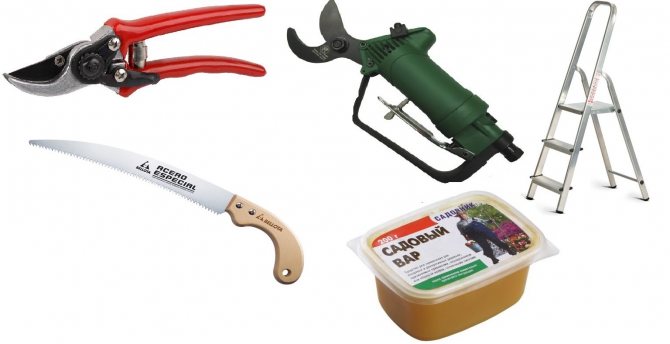

Use a stepladder, sharp garden tools, and a garden cutter to help you prune properly.
All instruments must be sharpened and disinfected before use. In addition, you will need garden varnish or oil paint to cover the cuts.
Pruning a pear seedling after planting
As soon as you plant a pear seedling, you need to do the first, main pruning, which has 2 goals at once:
- The root system of the tree may be damaged during planting. In order for her to recover as quickly as possible, she needs nutrition, and shortening the branches will help provide it.
- The conductor will be shortened and thereby the scheme for the formation of the pear in the future will be laid.
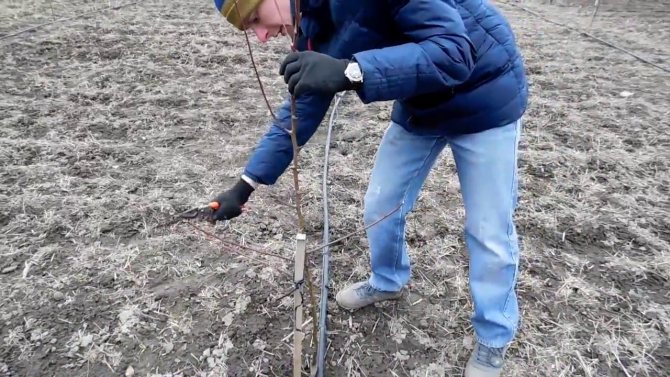

Prune the seedling immediately after planting to lay the foundation for the future crown.
In the fall of the first year of growth, the tree does not need pruning, since it was carried out when planting in the spring. If you follow all the rules, at the first stage you will provide the pear with good conditions for the healthy growth of the crown and its formation. You will only need to remove damaged shoots if necessary.
Pruning annual and young pears
A one-year-old sapling that was planted last year should be trimmed to at least a quarter of its total length (25%). This will help the crown plants become more branched.Lateral shoots are also shortened, but they are cut to the first bud.
After another year of the tree's life, the top of the trunk should be shortened by 25–30 cm, and all branches of the tree by 6–8 cm. In order for the crown to form correctly, the lower branches must remain longer than the upper ones. This pyramid-like crown shape is considered one of the best for pear fruiting.
After completing all these stages of pruning, follow the rules for caring for a pear plant. They are as follows:
- Perform a sanitary-type pruning every March to remove dry shoots and twigs showing signs of disease.
- After 2 weeks, carry out the forming stage in the same way as for the first time. When the pear becomes larger, the germination rate of new shoots will decrease, and formative pruning can be carried out once every 3 years.


For matured and mature pear trees, one pruning in 3 years will be enough
Formation of tiers in a pear seedling
For a year after planting, the pear tree has already taken root and has fully adapted. At this time, you need to begin the process of crown formation, which lasts three seasons and consists of several stages.
There are 5 types of pear crown shapes:
- sparse tiered;
- improved tiered;
- fusiform;
- bowl-shaped;
- semi-flat.
The choice of shape will determine the scheme used for pruning the branches.
There are different opinions about which crown shape is best. For example, a sparse-tiered form is recommended for beginners in gardening - it is easier to implement, and later allows you to correct some mistakes made during pruning. Gardeners with extensive experience, on the contrary, argue that the most practical are fusiform and bowl-shaped. The first is great for a small area where the pears are close to each other, the second greatly facilitates the collection of fruits.
Sparse tiered form
Despite its simplicity, the sparse-tiered crown scheme requires a careful approach. Let's consider it in more detail.
- In order to form a crown according to this scheme, in the first year of growth, the pear seedling must be cut to a height of 80 cm.If the tree has not reached the desired length, it is not worth cutting the top.
- The second year is the period of the formation of the trunk (trunk to the level of the lower branches). To do this, all branches below 50 cm from the soil level are cut from the center conductor. It is necessary to leave the 3 strongest side branches extending from the trunk at an angle of 45 °, and the central shoot. The rest of the branches are cut.
- Lateral shoots are pruned so that their length does not exceed 50-60 cm. Subsequently, branches of the second order above the lower tier will be formed on them. They should grow 40-50 cm from the trunk. The branches left as skeletal (main, extending from the trunk), which have not grown longer than 50 cm, are cut to a length of 35 cm. The central conductor should be 20-30 cm higher than the branches of the tier. If the conductor is weak, not exceeding the thickness of the diameter of the skeletal branches, it should rise 40 cm above the pruning line.
- In the third year, in the spring, you need to leave young shoots, the length of which is 25–40 cm (they will become fruiting). If necessary, shorten the skeletal branches to 50 cm. The branches with a diameter greater than the thickness of the conductor must be cut “into a ring”.
- If in the third year of growth the height of the pear is 2.5–3 m, it is necessary to limit the growth of the tree. This is done by the translation "to a lateral branch": the conductor is cut at a selected height above the young lateral branch.
So, a pear tree, the crown of which is formed according to the principle of a sparse-tiered scheme, consists of:
- center conductor;
- the first tier of 5–6 skeletal branches;
- 6–8 branches of the second order;
- semi-skeletal and overgrown fruit branches.
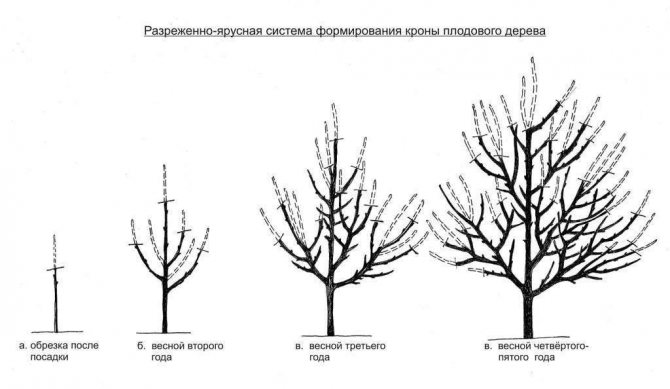

The sparse-tiered crown formation scheme is well suited for vigorous pears
The space between the tiers should be 50-60 cm.Leave for the skeleton branches spaced from the main conductor at an angle of 45-60 °. Please note that they should not interfere with the access of light to each other. To ensure this, check the angle of divergence between such branches: it should be at least 120 °. It is recommended to leave semi-skeletal branches only at the lower level.
Video: how to form a sparse-tiered crown on a fruit tree
Improved tiered layout
This method is similar to the previous one. The only difference is that you need to leave more skeletal branches. So in the lower tier there will be 4 skeletal branches, and in order to lay the second tier, you need to leave 5-6 buds. Over time, strong healthy shoots will appear from them, half of which will become the frame of the tier. So the pear will have two levels 50-60 cm apart with 6-8 frame branches.
The following schemes for an improved longline crown are recommended:
- The lower tier - 3-4 frame branches, the second tier - 2-3 frame branches, the third tier is absent, two single branches are left above the second tier.
- Lower tier - 3-4 frame branches; the second tier - 2-3 frame branches, the third tier - 2 frame branches, above the third tier 1-2 single branches are left.
Fusiform crown
The formation of a fusiform crown is very popular among professional gardeners. Fruiting in trees with such a crown begins early, and the yield increases. This is due to good ventilation and lighting of the branches.
A feature of the spindle-shaped scheme is the large number of semi-skeletal branches. With the garter method, they are given a horizontal position. The branches are arranged spirally, with a distance of 2–4 shoot buds between them.


Experienced gardeners most often choose a spindle-shaped crown.
This scheme has a drawback: the lower branches droop, complicating the maintenance of the soil around the trunk and cleaning the trunk. To avoid these troubles, you need to leave in the lower tier branches up to 1.5 m long, growing at an angle of 50-60 °. The branches that grow higher should have a horizontal direction.
Video: rules for the formation of a fusiform crown
Cup-shaped crown
This type of crown is also called vase. The scheme is referred to as a leaderless formation, in which skeletal branches grow at the same level (tier) on a stem 50 cm high.
In the first growing season, the center conductor is cut out. In this case, 3-4 frame branches remain, equidistant from each other. Each has 2 branches of the second level and 3-4 of the third level.
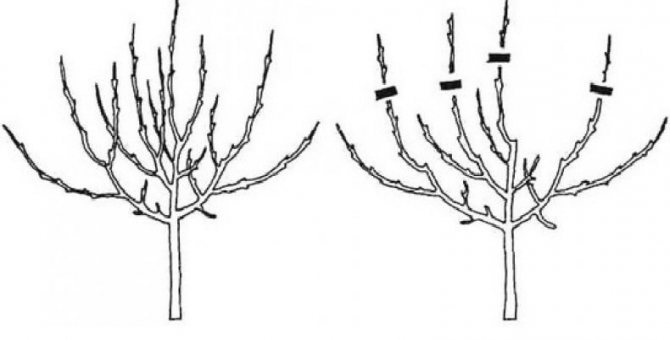

The cup-shaped crown is very convenient for harvesting
The cup-shaped crown is well illuminated by the sun from all sides, and it is also very convenient for harvesting. The disadvantages include the fragility of skeletal branches, which easily break under the weight of the fruit. But on the other hand, such trees are less susceptible to fungal diseases.
Rejuvenating pear pruning in spring
A special pruning method is used when it is necessary to rejuvenate the fruit plantations. Such an event is very important for trees over 15 years old. To effectively restore the fruit-forming ability of an old pear, it is recommended to adhere to the following pruning technology:


- it is best to perform anti-aging pruning in several stages, observing the time interval between the activities carried out in a couple of years;
- at the first stage, shoots should be removed that are located at an acute angle to the stem;
- you should also remove all shoots located in a parallel direction to the trunk of the fruit tree;
- when pruning branches, you cannot leave hemp or deeply deepen the cut, since in this case the healing process is greatly delayed;
- competent pruning is carried out in a way on the ring, which contributes to the fastest healing of the slices;
- with a branch thickness of more than 3 cm, it is first necessary to make cuts from the bottom and top, which will not allow the plant to be severely damaged;
- all cuts must be processed with a garden varnish without fail.
We advise you to read these articles:
Fertilizing the soil in spring
What to do if the pepper does not rise
Feeding petunia seedlings for growth at home
It is important to note that the annual growth in pear trees, unlike apple trees, is not recommended to be pruned very strongly. Shortening by a quarter of the original length is considered optimal. After the main anti-aging pruning, the crown is thinned and shoots are removed that are directed deep into the crown or intersect with each other.
Why prune a pear
The fruits of some varieties of pears can grow to large sizes, so the tree must be prepared in advance for heavy loads and properly formed. It is necessary to start at the stage of primary development.
Regular pruning helps to create a strong plant skeleton that can withstand the weight of the fruit. Also, a properly formed crown facilitates the harvesting process, provides access to air and light, and simplifies maintenance and preventive treatments.


If you form the crown of a pear correctly, it will withstand any harvest.
I practice two types of pruning - shortening and thinning. If I see that the tree has grown a lot, then I cut off the upper shoots from the crown. The second pruning option prevents thickening, promotes better air circulation.
How pears respond to pruning
Sometimes a pear reacts to pruning not the way you would like it to, and grows "in the wrong steppe." Such disobedience depends on the variety and the type of growth inherent in it. Therefore, sometimes light pruning is combined with other techniques, for example, bending. There are varieties with apical (apical) domination of shoots, there are with lateral. There are good shoots, there are bad ones. There are varieties with right angle shoots, there are sharp ones (mesotonic and basitonic).
Varieties with a mesotonic type of branching with a wide angle of branching are excellently formed: Pamyati Yakovlev, Avgustovskaya dew, Lastochka. It is a pleasure to form such varieties - we cut a young seedling to a stem height of + 20 cm and remove unnecessary lateral shoots in the summer - the tree forms itself. The formation pattern for such pears is sparse-tiered.
And a variety like Bryanskaya Krasavitsa has top dominance. Those. all the strength of growth goes into one single shoot, which simply clogs the rest. It is impossible to form such a tree by pruning! When pruning, one or two shoots are obtained, but with such sharp angles that they literally run parallel to the trunk. Such varieties are formed by horizontal cordons. This is when one shoot is kicked out, and then it is bent. The shoots that have grown from the places of bending are thinned out and again bend in the opposite direction, etc.
Competent haircut
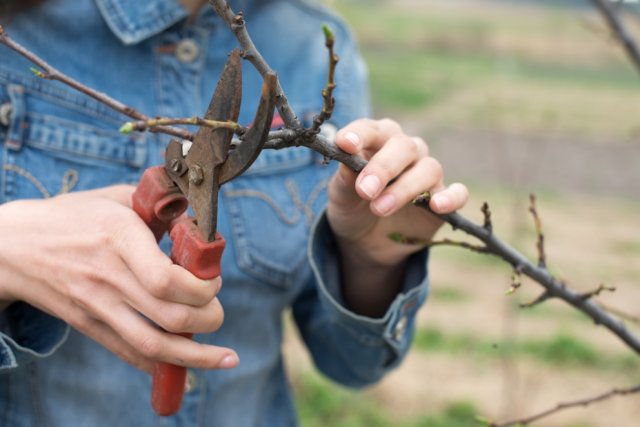

The pear is a representative of horticultural crops that needs abundant sunlight and at all stages of growth. For her, a shaping haircut is carried out together with a supporting and sanitary one. Then all the juices and beneficial compounds go to the fruits. This has a positive effect on the taste and marketability of fruits. In addition, correct pruning will limit the upward development of the pear, making it easier to harvest.
For your information!
If the shortening is done in the spring, it is better not to fertilize the plant with nitrogen fertilizers. After pruning, it will intensively draw out nutrients from the soil, which will affect the flavor characteristics of the fruit.
Young tree
A haircut is carried out the next year after planting the planting material, when it will take root well and get stronger. The first procedure is the most responsible: the formation of the trunk, skeletal branches, and crown depends on it.Pruning of young pears is carried out in the spring, when the plant, upon awakening, has the necessary reserve of strength to overgrow damage and resist diseases. In addition, shortening the shoots by a quarter increases branching and fruit shoot formation.
Adult pear
The basic rule of pruning a fruiting plant is not to harm it. If you inflict serious damage on a tree, it will need to spend energy on restoration. This will lead to a shortage of fruits and a deterioration in their taste. In the formed pear, internal shoots are cut out, excessively shading the crown, the central trunk is shortened by a quarter. In addition, they limit the length of skeletal branches, cutting them to one size, and remove competitors.
Old tree
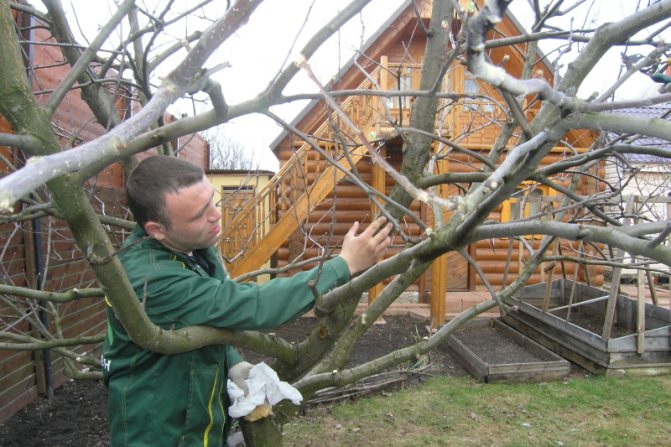

The pear is rejuvenated to restore its fruiting ability. After the procedure, the fruit grows healthier and more juicy. So, gardeners artificially increase the quality of the fruit. Rejuvenating pruning is needed to give the crown an open-center, bowl-like shape. This ensures good air circulation, more sunlight gets on the leaves, which has a beneficial effect on the future harvest.
Formation of a columnar pear
In this case, beginners should be especially careful, since the basic pruning scheme differs significantly from the traditional method. The thing is that this variety cannot boast of a highly branching crown. So that she is neat, and the tree gives a lot of fruits, you need to follow the following rules:


- The central trunk-column (conductor) is shortened for the first time not earlier than five years after planting the seedling in open ground. If the gardener takes proper care of the tree, then it will grow by 15-18 cm per year.
- If the uppermost bud was damaged, and several new shoots have already formed on the pear, then one of them must be cut off under the ring, leaving only the healthiest one.
- Proper care of a columnar tree is based on thinning out the lateral branches. Only weakened, damaged and dry branches should be removed. In addition, thinning is extremely important in cases where the quantity and quality of ripe fruit has significantly decreased.

